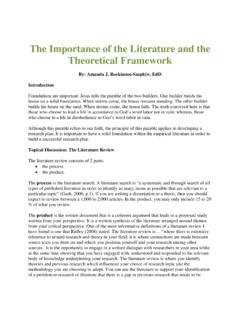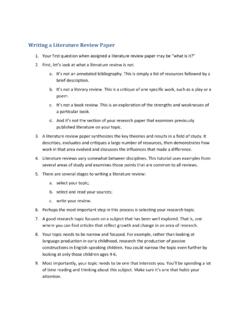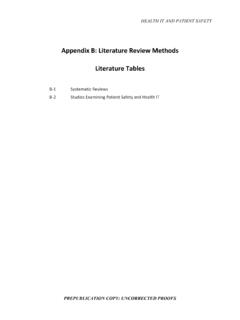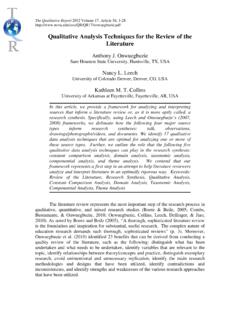Transcription of Teaching Critical Thinking Skills: Literature Review
1 TOJET: The Turkish Online Journal of Educational Technology January 2020, volume 19 issue 1 Copyright The Turkish Online Journal of Educational Technology 21 Teaching Critical Thinking Skills: Literature Review Nada J. Alsaleh Assistant Professor at the Instructional Technology Department, School of Education - King Saud University, Riyadh, Saudi Arabia nsaleh@ict_nada Funding: This research is funded by Deanship of Scientific Research at King Saud University. Acknowledgment: The author extend their appreciation to the Deanship of Scientific Research at King Saud University for funding this work through Thesis Publication Fund No (TPF-006).
2 ABSTRACT Critical Thinking (CT) has been recognized as one of the most important Thinking skills and one of the most important indicators of student learning quality. In order to develop successful Critical thinkers, CT must be incorporated into the curriculum content and Teaching approaches and sequenced at all grade levels. This research provides a systematic Review of the extant Literature on Teaching CT skills. The comprehensive Review led to the building of a conceptual framework that discusses the four main debates among the researchers engaged in the field of Teaching CT. One of these debates; can technology promote students CT skills?
3 Overall, the study of actual practices indicates that Teaching approaches tend to focus on subject content rather than CT development. The results indicate a gap in Teaching CT skills in terms of innovative methods and particularly in the use of new technologies. They also highlight the need for further research that investigates new approaches for Teaching CT skills. KEYWORDS: Critical Thinking skills, Teaching Critical Thinking , assisting Critical Thinking , technology to promote Critical Thinking . INTRODUCTION Although the importance of Critical Thinking (CT) skills in the learning process is agreed upon, there is less agreement about how CT is defined (Alfadhli 2008).
4 The first serious discussions and analyses of CT were conducted by John Dewey (1916, cited in Kuhn 1999), who discussed the concept of CT skills in education. Dewey perceived CT as a process that begins with a problem and ends with a solution and self-interpretation. Bean (2011, p. 3) elaborates on this point by stating that such a problem should evoke students natural curiosity and stimulate both learning and Critical thought . Many researchers agree with Dewey s point of view that CT begins with students engagement with a problem. For example, Kurfiss (1988, p. 2) defined CT as an investigation whose purpose is to explore a situation, phenomenon, question, or problem to arrive at a hypothesis or conclusion about it that integrates all available information and that can therefore be convincingly justified.
5 Moreover, Pithers and Soden (2000, p. 238) state that Critical Thinking involves being able to identify questions worth pursuing, being able to pursue one s questions through self-directed search and interrogation of knowledge, a sense that knowledge is contestable and being able to present evidence to support one s arguments . This suggests that CT can be defined as an individual thought process that begins with the intent to solve a problem or to answer a question, by examining different options and choosing the most suitable and logical one. From a cognitive psychologist s view, Halpren (1997, p. 4) emphasises that CT is the use of those cognitive skills or strategies that increase the probability of a desirable outcome.
6 It is used to describe Thinking that is purposeful, reasoned and goal directed . Halpren (1997, p. 4) states, Critical Thinking is purposeful, reasoned, and goal-directed. It is the kind of Thinking involved in solving problems, formulating inferences, calculating likelihoods, and making decisions. Critical thinkers use these skills appropriately, without prompting, and usually with conscious intent, in a variety of settings . In other words, when people think critically, they evaluate the outcomes of their thought processes, calculate how good a decision is, or identify how effectively a problem has been solved.
7 Furthermore, Paul (1992, p. 1) states that CT is the intellectually disciplined process of actively and skilfully conceptualizing, applying, analysing, synthesising, and/or evaluating information gathered from, or generated by observation, experience, reflection, reasoning, or communication as a rubric to belief and action . Paul and Elder (2006, p. 4) expand on this point of view by defining CT as the art of analysing and evaluating Thinking with a TOJET: The Turkish Online Journal of Educational Technology January 2020, volume 19 issue 1 Copyright The Turkish Online Journal of Educational Technology 22 view to improve it . These definitions indicate that CT is the ability to apply cognitive skills, such as analysing, applying, and evaluating when Thinking .
8 Based on the above Review of CT definitions, it is important to note that no single definition of CT is applicable to every discipline at every level. Although researchers generally agree that CT is a high-level Thinking skill, teachers experiences and goals, as well as students needs, determine the specific skills to be developed (Condon & Kelly-Riley 2004). This study provides a systematic Review of the Literature on Teaching CT skills focusing on published articles in academic journals as well as dissertations in this field. The rest of the article is organised as follows: First, the method used to identify and select studies for inclusion in this Review is described.
9 The article then presents the conceptual framework of the study and discusses the Literature considering the four main debates among researchers in the field of Teaching CT. Finally, the limitations of existing studies on Teaching CT skills are listed and the suggestions for further studies. METHOD A systematic Literature Review was conducted, which focused on describing and discussing the topic from theoretical and conceptual viewpoints. This study followed the British Educational Research Association s guidelines for conducting a systematic Review (Cohen, Manion, & Morrison 2011). First, an initial search for appropriate sources was conducted using Google Scholar and electronic databases from several academic fields such as education and psychology to identify CT-related articles.
10 A variety of search terms were used including different variations and combinations of the following terms: Critical Thinking skills , Teaching Critical Thinking skills , high-level Thinking skills , innovative way to teach Critical Thinking skills , and Critical Thinking cross curriculum . Second, the abstracts were read to screen the initial list of articles for the five main topics ( Teaching CT skills, assessing CT skills, strategies to teach CT skills, CT skills taxonomy, and using technology to teach CT skills). Later, these five topics were used to form the base of the conceptual framework of the present study. Third, a conceptual framework was designed, which summarised the main arguments among the researchers in this field, as will explained later.














